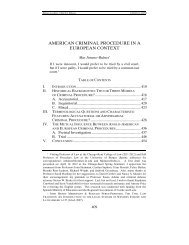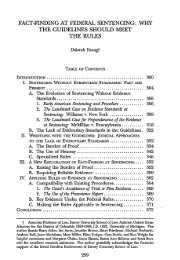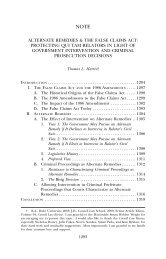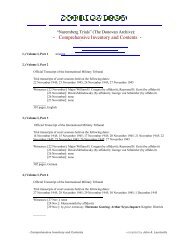gender, sex, agency and discrimination - Cornell University Law ...
gender, sex, agency and discrimination - Cornell University Law ...
gender, sex, agency and discrimination - Cornell University Law ...
You also want an ePaper? Increase the reach of your titles
YUMPU automatically turns print PDFs into web optimized ePapers that Google loves.
GENDER, SEX, AGENCY AND DISCRIMINATION: A<br />
REPLY TO PROFESSOR ABRAMS<br />
Katherine M. Franket<br />
According to the Equal Employment Opportunity Commission,<br />
<strong>sex</strong>ual harassment is the fastest-growing area of employment <strong>discrimination</strong>.'<br />
In fact, the annual number of <strong>sex</strong>ual harassment complaints<br />
filed with the EEOC has more than doubled in the last six years. 2 No<br />
one, or at least no one who has given this problem her serious attention,<br />
can deny that workplace <strong>sex</strong>ual harassment is a grave problem<br />
<strong>and</strong> that it significantly impedes women's entrance into many sectors<br />
of the wage labor market.<br />
Notwithst<strong>and</strong>ing these impressive numbers, <strong>sex</strong>ual harassment<br />
legal doctrine remains remarkably undertheorized-particularly by<br />
the Supreme Court. For these <strong>and</strong> other reasons, Professor Abrams<br />
does a tremendous service by critiquing <strong>and</strong>, in many ways, refining<br />
the work that Anita Bernstein, Vicki Schultz, <strong>and</strong> I have done on the<br />
problem of <strong>sex</strong>ual harassment. She seeks to signal the arrival of ajurisprudential<br />
moment characterized by reinvigorated theorizing about<br />
the appropriate legal response to <strong>sex</strong>ual harassment. Professor<br />
Abrams is a particularly appropriate person to undertake such an exercise<br />
given that she has produced some of the most innovative recent<br />
scholarship on <strong>sex</strong>ual harassment. 8 Moreover, this is a particularly opportune<br />
time to make such an assessment of the law of <strong>sex</strong>ual harassment,<br />
as the Supreme Court will have taken action in five <strong>sex</strong>ual<br />
harassment cases this term. 4 Finally, what better time to assess the<br />
f Associate Professor of <strong>Law</strong>, Fordhain <strong>University</strong> School of <strong>Law</strong>.<br />
1 See Kirstin Downey Grimsley, Wor*er Bias Cases Are Rising Steadily: New <strong>Law</strong>s Boost<br />
Hopes for Monetary Awards, WAsH. Posr, May 12, 1997, at Al.<br />
2 Seeid.<br />
3 See, e.g., Kathryn Abrams, Gender Discrimination <strong>and</strong> the Transformation of Workplace<br />
Norms, 42 VAND. L. REV. 1183 (1989); Kathryn Abrams, Title VII <strong>and</strong> the Complex Female Subject<br />
92 MICH. L. Rxv. 2479 (1994) [hereinafter Abrams, Complex Female Subject]; Kathryn<br />
Abrams, The Reasonable Woman: Sense <strong>and</strong> Sensibility in Sexual Harassment <strong>Law</strong>, DlssEx'r, Winter<br />
1995, at 48.<br />
4 Oncale v. Sundowner Offshore Servs., Inc., 118 S. Ct. 998 (1998) (holding that<br />
same-<strong>sex</strong> <strong>sex</strong>ual harassment can be actionable under Title VII);Jansen v. Packaging Corp.<br />
of America, 123 F.2d 490 (7th Cir. 1997), cert. granted in part sub nom, Burlington Indust.,<br />
Inc. v. Ellerth, 118 S. Ct. 876 (1998) (establishing whether <strong>sex</strong>ually harassing conduct that<br />
does not result in an adverse job action is actionable under Title VII); City of Belleville v.<br />
Doe, 119 F.3d 563 (7th Cir. 1997), vacated, 118 S. Ct. 1183 (1998); Faragher v. City of Boca<br />
Raton, 111 F.3d 1530 (l1th Cir. 1997), cert. granted, 118 S. Ct. 438 (1997) (establishing<br />
st<strong>and</strong>ards of employer liability for peer <strong>sex</strong>ual harassment); Doe v. Lago Vista Ind. School<br />
Dist., 106 F.3d 1223 (5th Cir.), cert. granted sub nom. Gebser v. Lago Vista Ind. School Dist.,<br />
1245
1246 CORNELL LAW REVIEW [Vol. 83:1245<br />
state of <strong>sex</strong>ual harassment doctrine than on the eve of the twentieth<br />
anniversary of the publication of Catharine MacKinnon's Sexual Harassment<br />
of Working Women. 5<br />
In The New Jurisprudence of Sexual Harassment, 6 Professor Abrams<br />
voices several concerns about my formulation of the wrong of <strong>sex</strong>ual<br />
harassment as a <strong>gender</strong>-based harm. I have argued that "<strong>sex</strong>ual harassment<br />
is <strong>sex</strong> <strong>discrimination</strong> precisely because its use <strong>and</strong> effect police<br />
hetero-patriarchal <strong>gender</strong> norms in the workplace." '7 To the<br />
contrary, Abrams suggests that the wrong of <strong>sex</strong>ual harassment lies in<br />
its power to "preserve male control <strong>and</strong> entrench masculine norms in<br />
the workplace." 8 I suspect that only the overinitiated will regard the<br />
two -of us to be- formulating different theories of <strong>discrimination</strong>. To<br />
be perfectly honest, I read much of Abrams's article as an elaboration<br />
of, rather than a disagreement with, the theory I advanced in What's<br />
Wrong With Sexual Harassment? Surely this should come as no great<br />
surprise since it is upon Professor Abrams's work that I aimed to build<br />
my account of the discriminatory nature of <strong>sex</strong>ual harassment. 9 Thus,<br />
I regard my comments here not in Marshal McLuhan-terms from Annie<br />
Hall, 10 but as one new iteration of an ongoing conversation the<br />
two of us have undertaken with respect to the "why," not the "what," of<br />
<strong>sex</strong>ual harassment.<br />
I take Professor Abrams to express three major concerns about<br />
my work" 1 in The New Jurisprudence. First, she, like Professor Schultz, 12<br />
does not want to lose sight of the fact that the conduct prohibited by<br />
Tide VII is conduct that disadvantages its targets as workers. For<br />
Abrams, any complete theory must account for the special relation<br />
<strong>sex</strong>ual harassment has to the workplace. 13 Second, she is wary of any<br />
theory of <strong>sex</strong>ual harassment that fails to frame its analysis around a<br />
118 S. Ct. 595 (1997) (establishing whether school <strong>sex</strong>ual harassment claims are actionable<br />
under Title IX).<br />
5 CATHARINE A. MACKINNON, SExuAL HARASSMENT OF WORKING WOMEN: A CASE OF<br />
SEX DISCRIMINATION (1979).<br />
6 Kathryn Abrams, The New Jurisprudence of Sexual Harassment, 83 CORNELL L. Rxv.<br />
1169 (1998).<br />
7 Katherine M. Franke, What's Wrong With Sexual Harassment, 49 STAN. L. REv. 691,<br />
772 (1997).<br />
8 Abrams, supra note 6, at 1172.<br />
9 Franke, supra note 7, at 762.<br />
10 Man in Line at movie theater whom Woody Allen character finds irritating. "I happen<br />
to teach a class at Columbia called 'TV Media <strong>and</strong> Culture'! So I think that my insights<br />
into Mr. McLuhan-well, have a great deal of validity." Marshall McLuhan, who is st<strong>and</strong>ing<br />
nearby in the theater: "You-you know nothing of my work .... How you ever got to<br />
teach a course in anything is totally amazing." Woody Allen & Marshall Brickman, Screenplay<br />
of Annie Hall, in FOUR Fiums OF WOODY ALLEN 16 (1982).<br />
11 I will limit my comments to Abrams's commentary on my work <strong>and</strong> will leave to<br />
Professor Bernstein the task of addressing the first part of Abrams's article.<br />
12 Vicki Schultz, Reconceptualizing Sexual Harassment, 107 YALE L.J. 1683 (1998).<br />
13 Abrams, supra note 6, at 1193-94.
1998] GENDER, SEX, AGENCY<br />
1247<br />
central premise of women's subordination. 14 Third, Abrams resists an<br />
account of <strong>sex</strong>ual harassment as an instrument of what she calls "<strong>gender</strong><br />
confinement,"' 5 preferring instead to underst<strong>and</strong> <strong>sex</strong>ual harassment<br />
understood as "an interference with human <strong>agency</strong>, <strong>and</strong><br />
particularly the <strong>agency</strong> of women. 1' 6 I will address each of these concerns<br />
in tram.<br />
Without question, the workplace is a domain unique in its relationship<br />
to identityformation,' 7 liberatory promise, 18 <strong>and</strong> the imposition<br />
of legal equality norms. 19 The key question, for our purposes, is<br />
whether the <strong>sex</strong>ual harassment that occurs in the workplace differs<br />
sufficiently from the <strong>sex</strong>ual harassment that occurs in other fora such<br />
that it dem<strong>and</strong>s a unique analysis. In other words, is workplace <strong>sex</strong>ual<br />
harassment in some way distinguishable from, for instance, the discriminatory<br />
nature of the <strong>sex</strong>ual harassment of female students?<br />
While Abrams provides compelling arguments regarding the<br />
unique injuries that female harassment victims suffer qua workers, 20 I<br />
am unconvinced that this injury is sufficiently different in kind from<br />
that suffered by girls who are <strong>sex</strong>ually harassed in school to warrant<br />
such a critique. Take, for example the experience of LaShonda Davis,<br />
a girl who in the fifth grade reported that a male classmate fondled<br />
her, touched her breasts <strong>and</strong> vaginal area, told her, "I want to get in<br />
bed with you," <strong>and</strong> "I want to feel your boobs," rubbed against her in<br />
the hallway in a <strong>sex</strong>ually suggestive manner, <strong>and</strong> placed a doorstop in<br />
his pants <strong>and</strong> behaved in a <strong>sex</strong>ually suggestive manner toward her. 21 The boy's actions increased in severity until he finally was charged<br />
with, <strong>and</strong> pled guilty to, <strong>sex</strong>ual battery. 22 LaShonda, her mother, <strong>and</strong><br />
other girls complained to teachers <strong>and</strong> the principal about this boy's<br />
behavior, but the school did nothing. 23 LaShonda's grades dropped<br />
from As <strong>and</strong> Bs, <strong>and</strong>, at one point, she even wrote a suicide note. 2 4<br />
14 Id. at 1214-15.<br />
15 Id. at 1209. I believe Abrams uses this term to describe the theory I advance in<br />
What's Wrong With Sexual Harassment? I resist the reduction of my theory of the wrong of<br />
<strong>sex</strong>ual harassment to a notion of <strong>gender</strong> confinement.<br />
16 Id. at 1172.<br />
17 As Abrams points out, <strong>and</strong> Schultz develops at even greater length in Marxian materialist<br />
terms, the workplace is a site of resistance where women can gain "a sense of competence<br />
or independence that they had not enjoyed before." Id. at 1195.<br />
18 As Abrams states, "[t]hese harms are particularly salient because they occur in a<br />
context viewed by many women as having liberatory potential, in both material <strong>and</strong> personal<br />
terms." Id. at 1218.<br />
19 See, e.g., Title VII of the Civil Rights Act of 1964, 42 U.S.C. § 2000e (1994).<br />
20 Abrams, supra note 6, at 1194-1205.<br />
21 Davis v. Monroe County Bd. of Educ., 74 F.3d 1186, 1188-89 (11th Cir.), vacated, 91<br />
F.3d 1418 (11th Cir. 1996), on reh'g, 120 F.3d 1390 (11th Cir. 1997), petitionfor cert. filed, 66<br />
U.S.L.W. 3387 (U.S. Nov. 19, 1997).<br />
22 See id. at 1189.<br />
23 See id.<br />
24 See id.
1248 CORNELL LAW REVIEW [Vol. 83:1245<br />
Tragically, LaShonda's experience is not atypical. One survey reported<br />
that eighty-five percent of female respondents in grades eight<br />
through eleven have been <strong>sex</strong>ually harassed. 25 School is a place where<br />
girls can gain a sense of themselves as competent, confident, <strong>and</strong> independent<br />
individuals, <strong>and</strong> where they are valued more for their<br />
minds than for their bodies. Sexual harassment of girls, most of it in<br />
the form of hostile environment <strong>sex</strong>ual harassment by peers, is widespread<br />
in schools <strong>and</strong> affects girls educationally, emotionally <strong>and</strong> physically.<br />
Girls who have been harassed are more afraid in school <strong>and</strong><br />
feel less confident about themselves. 26 As the Department of Education<br />
has recognized, "<strong>sex</strong>ual harassment can interfere with a student's<br />
academic performance <strong>and</strong> emotional <strong>and</strong> physical well-being....<br />
preventing <strong>and</strong> remedying <strong>sex</strong>ual harassment in schools is essential to<br />
ensure nondiscriminatory, safe environments in which students can<br />
learn." 27<br />
Enforcement of prohibitions against <strong>sex</strong> <strong>discrimination</strong>, including<br />
<strong>sex</strong>ual harassment, in the schools has increased of late. The Department<br />
of Education's Office of Civil Rights recently issued<br />
guidance in interpreting Tite IX of the Education Amendments of<br />
1972 to prohibit <strong>sex</strong>ual harassment in schools. 28 Should we conclude<br />
that the wrong of school-based <strong>sex</strong>ual harassment is different in some<br />
principled way from the wrong of workplace <strong>sex</strong>ual harassment? I do<br />
not think so. Abrams writes that "[e]ntering the workforce also gave<br />
women the chance to develop conceptions both of themselves <strong>and</strong> of<br />
their goals, which were at least partially independent of the men<br />
whose lives often structured their own." 29 Here she is referring partic-<br />
25 AMERICAN ASS'N OF UNIV. WOMEN EDUC. FOUND., HosuLE HALLwAyS: THE AAUW<br />
SURVEY ON SEXUAL HARASSMENT IN AMERICA'S SCHooLs 7 (1993).<br />
26 See id. at 16-17.<br />
27 Sexual Harassment Guidance: Harassment of Students by School Employees, Other<br />
Students, or Third Parties, 62 Fed. Reg. 12,034, 12,034 (1997) [hereinafter Sexual Harassment<br />
Guidance]; see also OFFICE FOR CIL RiCHTs, U.S. DEP'T OF EDUC., SEXUAL HARASS-<br />
MENT: IT'S NOT ACADEMIC (1997) (noting that "[s]exual harassment can threaten a<br />
student's phyiscal or emotional well-being, influence how well a student does in school,<br />
<strong>and</strong> make it difficult for a student to achieve his or her career goals."); NAN STEIN, SECRETS<br />
IN PUBLIC: SEXUAL HARASSMENT IN PUBLIC (AND PRIVATE) ScHooLs (Center for Research on<br />
Women Working Paper No. 256 (1993) (recounting the effects of <strong>sex</strong>ual harassment on<br />
students)).<br />
28 Sexual Harassment Guidance, supra note 27, at 12,034. The Guidance indicates<br />
that "if harassment is based on conduct of a <strong>sex</strong>ual nature, it may be <strong>sex</strong>ual harassment<br />
prohibited by Title IX even if the harasser <strong>and</strong> the harassed are the same <strong>sex</strong> or the victim<br />
of harassment is gay or lesbian." Id. at 12,036. With respect to this definition, I share<br />
Professors Abrams <strong>and</strong> Schultz's concern that this definition is limited to conduct of a<br />
<strong>sex</strong>ual nature, thereby ignoring, by implication, harassment of a non<strong>sex</strong>ual nature which<br />
is, without question, <strong>sex</strong> based harassment. Of course, this definition reproduces the<br />
Equal Employment Opportunity Commission's error of omission in failing to promulgate<br />
guidelines describing non<strong>sex</strong>ually explicit <strong>sex</strong> based harassment. See Franke, supra note 7,<br />
at 710 n.89, 717 n.128.<br />
29 Abrams, supra note 6, at 1196.
1998] GENDER, SEX AGENCY<br />
1249<br />
ularly to women's entrance into jobs that were not traditionally considered<br />
"pink collar" jobs. 30 Cannot the same be said for girls'<br />
enrollment in math, science, shop, 3 ' <strong>and</strong> other non-traditionally "feminine"<br />
courses?<br />
I raise the example of <strong>sex</strong>ual harassment in the schools to illustrate<br />
the ways in which the <strong>sex</strong>ual harassment of women by men in<br />
many different contexts, not just the workplace, operates as a means<br />
by which women are <strong>sex</strong>ualized, women are feminized, women's competence<br />
is called into question, <strong>and</strong> various public <strong>and</strong> private fora are<br />
preserved as domains best suited to hetero-masculine men. 32 Even<br />
though the harassment of men by women seemingly excuses men<br />
from the injury this conduct inflicts, I maintain that harassment of this<br />
kind serves to discipline men as well. Both the perpetrators of, <strong>and</strong><br />
male witnesses to, the <strong>sex</strong>ual harassment of women by men are subject<br />
to a regulatory practice that inscribes, enforces, <strong>and</strong> polices heteropatriarchal<br />
<strong>gender</strong> norms in men. Men who <strong>sex</strong>ually harass women<br />
are teaching both men <strong>and</strong> women a lesson about <strong>gender</strong>ed power.<br />
This lesson, discipline, or enactment of hetero-patriarchal power<br />
can take place in the workplace, schools, athletics, political institutions,<br />
<strong>and</strong> countless other institutional settings within any culture.<br />
Each location contributes a unique set of intersectional dynamics that<br />
render the sting of <strong>gender</strong> discipline painful <strong>and</strong> effective in different<br />
ways. However, this fact does not undermine the overarching notion<br />
that the wrong of <strong>sex</strong>ual harassment lies in its function as a technology<br />
of <strong>sex</strong>ism. Rather than neglect the role that work plays in our under-<br />
30 As Abrams describes, "[i]t also gave some women an opportunity both to perform<br />
roles distinct from those of caregiver, nurturer, object of affection or <strong>sex</strong>ual titillation <strong>and</strong><br />
to underst<strong>and</strong> more fully the constraint of those traditional roles by experiencing alternatives."<br />
Id. at 1195-96.<br />
31 I was one of the first girls in my high school to choose stage crew over home economics<br />
as a required extracurricular activity. The male students <strong>and</strong> teacher called me<br />
"Spike" because "Katherine" didn't sound right in the woodshop, <strong>and</strong> I was the object of<br />
incessant banana-related jokes from the male teacher after I showed up one afternoon<br />
eating a banana. While I kind of liked the name Spike, I definitely could have done without<br />
the banana jokes.<br />
32 I use the term "hetero-masculine men" advisedly, as I think neither masculinity nor<br />
maleness alone are what is being preserved through the use of <strong>sex</strong>ual harassment.<br />
Nonfeminine women, such as Ann Hopkins, see Price Waterhouse v. Hopkins, 490 U.S. 228,<br />
235 (1989) (noting a description of her as "macho"), non-masculine men, such as Anthony<br />
Goluszek, see Goluszek v. Smith, 697 F. Supp. 1452, 1453 (N.D. 111. 1988) (noting that the<br />
plaintiff was atypically sensitive to hetero<strong>sex</strong>ual male <strong>sex</strong>ual banter), <strong>and</strong> masculine gay<br />
men, such as Tom of Finl<strong>and</strong>, see F. VALENTNE HOOvEN III, TOM OF FrNLAND: His LIF= AND<br />
TiMFs (1993), do not have what it takes to pass unmolested in these venues. To the contrary,<br />
these kinds of people are the targets of frequent <strong>sex</strong>ual harassment when they seek to<br />
work in places such as shipyards, construction sites, <strong>and</strong> auto repair shops. For this reason,<br />
I would disagree with Abrams's description of <strong>sex</strong>ual harassment as something that<br />
"preserv[es] the workplace as a site of male control <strong>and</strong> normative influence." Abrams,<br />
supra note 6, at 1198. More than mere biological exclusivity drives this problem.
1250 CORNELL LAW REVIEW [Vol. 83:1245<br />
st<strong>and</strong>ing of <strong>sex</strong>ual harassment in the workplace, 33 I have tried to provide<br />
an overarching theory by which to underst<strong>and</strong> <strong>sex</strong>ual harassment<br />
generally as a kind of <strong>discrimination</strong> "because of <strong>sex</strong>." I chose to focus<br />
my discussion on workplace <strong>sex</strong>ual harassment primarily because this<br />
area has the most developed body of case law. This empirical convenience,<br />
however, should not deter us from searching for a way to underst<strong>and</strong><br />
workplace <strong>sex</strong>ual harassment not as a workplace wrong, but<br />
as a wrong grounded in <strong>gender</strong>-based <strong>discrimination</strong>.<br />
Next, I take Abrams to express concern about any theory that<br />
does not "place women's subordination at the center of <strong>sex</strong>ual harassment<br />
analysis. '3 4 Given my critique of Catharine MacKinnon's subordination<br />
theory, 3 5 Abrams takes me to hold the view that "the defects<br />
of the leading subordination based account make it dangerous or unwise<br />
to frame a theory of <strong>sex</strong>ual harassment around a central premise<br />
of women's subordination. '3 6 In my opinion, notwithst<strong>and</strong>ing this set<br />
up, Abrams <strong>and</strong> I agree more than we disagree about the normative<br />
priority of women's subordination in a theory of <strong>sex</strong>ual harassment.<br />
Some of our apparent disagreements can be attributed to different<br />
methodological preferences, while others can be understood as<br />
choices about depth of field; I am concerned about developing a theory<br />
that keeps women in the center of the frame, but that also keeps<br />
the effect that <strong>sex</strong>ual harassment has on men from falling out of view.<br />
I express this concern not because I think we should reposition victimized<br />
men at the center of <strong>sex</strong>ual harassment doctrine, but because I<br />
regard <strong>sex</strong>ual harassment to be a systemic dynamic, the full meaning<br />
of which cannot be understood by looking at women alone.<br />
The following short comments with respect to methodology are<br />
in order. In What's Wrong With Sexual Harassment, I devoted considerable<br />
attention to the problem of same-<strong>sex</strong> <strong>sex</strong>ual harassment, but I did<br />
so for the purpose of asking, admittedly in a provocative manner,<br />
"what exactly is wrong with <strong>sex</strong>ual harassment?" 37 I believe that by<br />
looking to the margins of a doctrine, much can be understood about<br />
tensions in the doctrine at the center. 38 The utility of attention to the<br />
33 Abrams claims that, "[a]t the most concrete level, <strong>sex</strong>ual harassment disadvantages<br />
its victims as workers.... [Because Franke does] not analyze <strong>sex</strong>ual harassment as a distinct<br />
phenomenon of the workplace, [she] tend[s] to treat these harms as peripheral." Abrams,<br />
supra note 6, at 1218 (emphasis added).<br />
34 Id. at 4.<br />
35 Franke, supra note 7, at 759-62.<br />
36 Abrams, supra note 6, at 1172.<br />
37 Franke, supra note 7, at 691.<br />
38 I used the same methodology in an earlier article in which I looked to the legal<br />
claims of trans<strong>gender</strong>ed persons in order to better underst<strong>and</strong> the overreliance upon biological<br />
<strong>sex</strong>ual differences in traditional <strong>sex</strong> <strong>discrimination</strong> jurisprudence. Katherine M.<br />
Franke, The Central Mistake of Sex Discrimination <strong>Law</strong>: The Disaggregation of Sex from Gender,<br />
144 U. PA. L. REv. 1, 40-69 (1995).
1998] GENDER, SEX, AGENCY<br />
1251<br />
"peculiar" has been a starting premise of cultural studies <strong>and</strong> anthropology<br />
for some time:<br />
it is often the "offbeat" (to our eyes) <strong>sex</strong>ual <strong>and</strong> <strong>sex</strong>-related practices<br />
... that help to bring the native theory most clearly to the fore,<br />
probably because being unclouded by obvious utilitarian aims their<br />
"symbolic" nature st<strong>and</strong>s out more boldly.<br />
The "peculiarity" reveals the underlying thought system <strong>and</strong><br />
the underlying thought system explains the peculiarity. 39<br />
Thus, my purpose in drawing attention to same-<strong>sex</strong> <strong>sex</strong>ual harassment<br />
cases was not to minimize or defer the importance or centrality<br />
of the <strong>sex</strong>ual harassment of women by men, but to provide a means by<br />
which to better underst<strong>and</strong> the underlying conception of <strong>sex</strong> <strong>discrimination</strong><br />
that animates traditional <strong>sex</strong>ual harassment doctrine.<br />
Related to the methodological point, yet of greater concern to<br />
me, is Abrams's reluctance to depart from a subordination-based theory<br />
of the wrong of <strong>sex</strong>ual harassment. I believe that any minimally<br />
adequate theory of <strong>sex</strong>ual harassment must provide an account of the<br />
meaning <strong>and</strong> legality of same-<strong>sex</strong> <strong>sex</strong>ual harassment. Yet, I take seriously<br />
Abrams's concern that my call to underst<strong>and</strong> <strong>sex</strong>ual harassment<br />
as a technology of hetero-patriarchy loses sight of the material reality<br />
of women's subordination:<br />
If it is possible to develop a theory of <strong>sex</strong> <strong>and</strong> <strong>gender</strong> subordination<br />
that extends to such phenomena as the oppression of nonconforming<br />
men, we may lose more than we gain by replacing that approach with a<br />
theory of hetero-patriarchy that addresses the <strong>gender</strong>ing of both men<br />
<strong>and</strong> women but fails to foreground women's subordination, in the context<br />
of <strong>sex</strong>ual harassment. 40<br />
If as nuanced a reader as Professor Abrams regards the theory I<br />
developed in What's Wrong With Sexual Harassment? to undervalue the<br />
importance of women's subordination, then I should clarify the central<br />
meaning of hetero-patriarchy for all readers. Again, I have Frank<br />
Valdes to thank for introducing this concept into the legal literature.<br />
4 1 As he <strong>and</strong> I use the term hetero-patriarchy, it refers to "the<br />
fusion of <strong>and</strong>ro<strong>sex</strong>ism <strong>and</strong> hetero<strong>sex</strong>ism, both socially <strong>and</strong> <strong>sex</strong>ually, to<br />
obtain <strong>and</strong> maintain the supremacy of 'masculinity' <strong>and</strong> of 'masculine'-identified<br />
(hetero<strong>sex</strong>ual) men, over personal, economic, <strong>and</strong><br />
39 Harriet Whitehead, The Bow <strong>and</strong> the Burden Strap: A New Look at Institutionalized Homo<strong>sex</strong>uality<br />
in Native North America, in SExuAL MEANINGS: THE CULTURAL CONSTRUCTION OF<br />
GENDER AND SExuAry 80, 82 (Sherry B. Ortner & Harriet Whitehead eds., 1981).<br />
40 Abrams, supra note 6, at 1204 (emphasis added).<br />
41 Francisco Valdes, Queers, Sissies, Dykes, <strong>and</strong> Tomboys: Deconstructing the Conflation of<br />
"Sex," "Gender, "<strong>and</strong> "Sexual Orientation" in Euro-American <strong>Law</strong> <strong>and</strong> Society, 83 CAL. L. REv. 1, 8<br />
n.14 (1995).
1252 CORNELL LAW REVIEW [Vol. 83:1245<br />
cultural life." 4 2 Indeed, the prominence of the term "patriarchy" in<br />
the term itself signals the importance of the historical <strong>and</strong> material<br />
subordination of women to men. 43 Abrams expresses concern that a<br />
theory of hetero-patriarchy fails to give sufficient recognition to the<br />
power of <strong>sex</strong>ual harassment to perpetuate male control <strong>and</strong> entrench<br />
male norms in the workplace. 44 Yet hetero-patriarchy, as I use it, analyzes<br />
<strong>gender</strong>ed power on two levels: one local <strong>and</strong> one systemic. First,<br />
it explains how various practices, such as <strong>sex</strong>ual harassment, actually<br />
do cultural work in the individual case-they <strong>gender</strong> males as masculine<br />
<strong>and</strong> females as feminine. 45 Second, it locates this <strong>gender</strong>ing<br />
within a systemic hierarchy of power in which women are regarded as<br />
inferior to men <strong>and</strong> femininity is regarded as inferior to masculinity. 46<br />
Reducing the theory of <strong>sex</strong>ual harassment I advance in What's Wrong<br />
With Sexual Harassment? to a theory of "<strong>gender</strong> confinement ' 47 focuses<br />
exclusively upon the first part of the analysis at the expense of the<br />
systemic aspect. Neither aspect can be fully understood without the<br />
other.<br />
What I find curious about Abrams's critique of the theory of<br />
hetero-patriarchy is that she finds it at once too flexible <strong>and</strong> too rigid<br />
an instrument with which to underst<strong>and</strong> the wrong of <strong>sex</strong>ual harassment.<br />
For Abrams, the theory is too flexible because, in extending<br />
the analysis to nonconforming men, the theory loses sight of women's<br />
subordination. 48 Yet it is too rigid, she argues, because it conflates<br />
<strong>and</strong> treats as equally significant multiple, simultaneous vectors of<br />
power based in <strong>sex</strong>, <strong>gender</strong>, <strong>and</strong> <strong>sex</strong>ual orientation. 49 I have already<br />
responded to the objection that the theory is too flexible. 50 I am troubled,<br />
however, by her claim that the theory is too rigid. One of the<br />
explanatory features of hetero-patriarchy that I find so satisfying is its<br />
capacity to provide an account for multiple trajectories of power: <strong>sex</strong>-<br />
42 Id.; see also Franke, supra note 7, at 739 n.247; Francisco Valdes, Unpacking Hetero-<br />
Patriarchy: Tracing the Conflation of Sex, Gender & Sexual Orientation to Its Origins, 8 YALE J.L.<br />
& HuMAN. 161, 170 (1996).<br />
43 Gerda Lerner has defined patriarchy as the "manifestation <strong>and</strong> institutionalization<br />
of male dominance over women <strong>and</strong> children in the family <strong>and</strong> the extension of male<br />
dominance over women in society in general." GERDA LERNER, THE CREATION OF PATRI-<br />
ARcHY 239 (1986).<br />
44 Abrams, supra note 6, at 1213-14.<br />
45 "According to this ideology, <strong>sex</strong> <strong>and</strong> <strong>gender</strong> ultimately collapse in such a way that<br />
femininity is understood as the authentic expression of female <strong>agency</strong> <strong>and</strong> masculinity is<br />
regarded as the authentic expression of male <strong>agency</strong>." Franke, supra note 7, at 762.<br />
46 See id.<br />
47 Abrams, supra note 6, at 1209.<br />
48 Id. at 1204.<br />
49 Id. at 1203-04. Hetero-patriarchy "obscure[s] variations among different kinds of<br />
subordination.... [It is] less helpful in describing environments in which some subordinating<br />
dynamics predominate." Id.<br />
50 See supra notes 35-42 <strong>and</strong> accompanying text.
1998] GENDER, SEX, AGENCY<br />
1253<br />
based, <strong>gender</strong>-based, <strong>and</strong> <strong>sex</strong>ual orientation-based. These dynamics<br />
tend to be mutually constitutive in a particular context-masculine<br />
power means different things depending upon whether the person<br />
exercising it is a gay or hetero<strong>sex</strong>ual man, or perhaps a woman trying<br />
to fit into an environment that prizes masculinity. 51 Even with respect<br />
to this last category, a masculine woman who is known to be hetero<strong>sex</strong>ual<br />
may be permitted to exercise different kinds of power or suffer<br />
different forms of harassment than a woman who is known to be a<br />
lesbian. 52 Hetero-patriarchy is designed to be flexible enough to respond<br />
to each of these complex situations. Abrams desires a theory<br />
that can explain the interrelation of power dynamics on a "context by<br />
context, institution by institution" basis. 53 Yet hetero-patriarchy,<br />
rather than a theory of women's subordination, seems best equipped<br />
to address the vagaries <strong>and</strong> complexities of <strong>sex</strong>ual harassment in a<br />
multitude of contexts.<br />
I might add that one of the dangers of recentering a theory of<br />
<strong>sex</strong>ual harassment on women's subordination-a danger evident in<br />
Abrams's paper-is the failure to recognize the reflexive quality of<br />
<strong>sex</strong>ual harassment. I regard it as extremely important that <strong>sex</strong>ual harassment<br />
be understood as a technology of <strong>sex</strong>ism that operates systemically<br />
to enforce hetero-patriarchal values. When a woman is <strong>sex</strong>ually<br />
harassed by a man, she is actually feminized in that process as a hetero<strong>sex</strong>ual<br />
object. However, the harasser does not remain unaffected; by<br />
exercising power in this way, he is heteromasculinized as a hetero<strong>sex</strong>ual<br />
subject. Abrams ignores the reflexive, performative power of <strong>sex</strong>ual<br />
harassment in her discussion, locating women <strong>and</strong> nonconforming<br />
men as the only persons affected by <strong>sex</strong>ual harassment.<br />
By refocusing our attention on the subordination of women, her field<br />
of vision no longer includes the ways in which <strong>sex</strong>ual harassment reinforces<br />
hetero-masculinity in all men. 54<br />
One particular example makes this omission clear. Abrams discusses<br />
how the entrance of women into traditionally all-male workplaces<br />
triggered various retaliatory responses from men who were<br />
anxious about the change in workplace culture that women's presence<br />
might presage, while at the same time they feared a loss of male<br />
control. 55 Abrams notes that "[t]hese assertions of male control in<br />
the workplace, however explained, have palpably affected the lives of<br />
51 Abrams, on the other h<strong>and</strong>, sees a looser relationship between these dynamics.<br />
Abrams, supra note 6, at 1203-04.<br />
52 One can only imagine the additional hostility that would have been directed at<br />
Shannon Faulkner or Ann Hopkins had either of them been openly lesbian.<br />
53 Abrams, supra note 6, at 1204.<br />
54 Id. at 1202 (stating that <strong>sex</strong>ualized aggression subordinates women <strong>and</strong> damages<br />
"some men" (emphasis added)).<br />
55 Id. at 1195-97.
1254 CORNELL LAW REVIEW [Vol. 83:1245<br />
women workers." 56 While this claim is unquestionably true, it is also<br />
the case that male reactions to the <strong>sex</strong>ual integration of many workplaces<br />
have palpably affected the lives of male workers <strong>and</strong> may have<br />
made the imposition of hetero-masculinity on men all the more extreme.<br />
When labor market arrangements no longer evidence the inevitability<br />
of <strong>gender</strong> <strong>and</strong> <strong>sex</strong>ual dimorphism, other means of<br />
reinforcing this "fact" must be resorted to. In circumstances in which<br />
masculinity is threatened because women are doing "men's jobs," it<br />
becomes all the more important to shore up hetero-masculine norms,<br />
frequently to levels that exceed those when the workplace was all<br />
male. Thus, a theory of the wrong of <strong>sex</strong>ual harassment must recognize<br />
both the performative <strong>and</strong> reflexive power of harassment for<br />
both men <strong>and</strong> women. 57<br />
Finally, I will address Professor Abrams's comments with respect<br />
to the <strong>agency</strong>-denying aspects of <strong>sex</strong>ual harassment. On the whole, I<br />
agree with her assertion that <strong>sex</strong>ual harassment is an offense to<br />
<strong>agency</strong>, in that it "interferes with the capacity to both define oneself as<br />
a subject <strong>and</strong> seek less stereotypic or confining roles." 58 Yet I believe<br />
that the connection between unwelcome conduct of a <strong>sex</strong>ual nature<br />
<strong>and</strong> <strong>agency</strong> must be drawn with a somewhat finer point. Abrams focuses<br />
her <strong>agency</strong>-related inquiry on whether the perpetrator acted on<br />
his desire in a way that was unilateral <strong>and</strong> without reference to the<br />
desire of the target. 59 As presented, I am not convinced that a theory<br />
regarding the denial of <strong>sex</strong>ual <strong>agency</strong> is necessarily a theory of <strong>discrimination</strong>.<br />
Recall that unlike Professor Bernstein, Professor Abrams<br />
56 Id. at 1197.<br />
57 Abrams makes one additional argument in favor of grounding a theory of <strong>sex</strong>ual<br />
harassment in women's subordination, this one more practical than theoretical. Abrams<br />
notes that the legal instruments we now possess, such as Tide VII, which address the problem<br />
of <strong>sex</strong> <strong>and</strong> <strong>gender</strong> based subordination, all target <strong>sex</strong> <strong>discrimination</strong>. Id. at 1204-05. She<br />
questions whether these statutes can accommodate a multifaceted theory of <strong>sex</strong> <strong>and</strong> <strong>gender</strong><br />
subordination. Id. Yet courts, including the Supreme Court, have consistently interpreted<br />
both Title VII <strong>and</strong> the Fourteenth Amendment to apply not only to <strong>sex</strong><br />
<strong>discrimination</strong>-the differential treatment of men <strong>and</strong> women simpliciter-but also to<br />
<strong>gender</strong> based <strong>discrimination</strong>. See, e.g.,J.E.B. v. Alabama ex rel. T.B., 511 U.S. 127, 139 n.11<br />
(1994) (equal protection principles, as applied to <strong>gender</strong> classifications, mean state actors<br />
may not rely on "overbroad" generalizations to make "judgments about people that are<br />
likely to... perpetuate historical patterns of <strong>discrimination</strong>"). Indeed, most courts routinely<br />
use the terms "<strong>sex</strong>" <strong>and</strong> "<strong>gender</strong>" interchangeably in discussing statutes prohibiting<br />
<strong>sex</strong> <strong>discrimination</strong>, at times denoting <strong>discrimination</strong> based upon biological differences <strong>and</strong><br />
at other times denoting <strong>discrimination</strong> based upon cultural differences; Price Waterhouse<br />
v. Hopkins, 490 U.S. 228 (1989) (holding that <strong>discrimination</strong> against non-feminine woman<br />
is <strong>sex</strong> <strong>discrimination</strong>). See Franke, supra note 38, at 9-14. Curiously, Justice Scalia is the<br />
only member of the Supreme Court to note a difference in meaning between <strong>sex</strong> <strong>and</strong><br />
<strong>gender</strong>. SeeJE.B., 511 U.S. at 157 n.1 (Scalia, J., dissenting).<br />
58 Abrams, supra note 6, at 1220.<br />
59 Id. at 1228.
1998] GENDER, SEX, AGENCY<br />
1255<br />
<strong>and</strong> I are struggling to develop an acceptable account of <strong>sex</strong>ual harassment<br />
as a form of <strong>sex</strong> <strong>discrimination</strong>.<br />
Abrams gives us an example in which a male perpetrator <strong>sex</strong>ually<br />
solicits a male target, apparently as an expression of <strong>sex</strong>ual desire.<br />
Abrams acknowledges that, particularly under a theory of <strong>sex</strong>ual harassment<br />
grounded in the subordination of women, it is difficult to<br />
provide an account of these cases that shows them to be <strong>sex</strong>ually discriminatory<br />
because "<strong>sex</strong>ual advances directed at male targets do not<br />
characteristically demean women as a group." 60 For Abrams, these<br />
cases would be actionable if one of two factors could be shown: the<br />
conduct was unilateral or disregarded the desires of the target in a way<br />
that tended to deny the <strong>sex</strong>ual <strong>agency</strong> of the target, or the conduct<br />
was "entrenched in the workplace stereotypic notions of male <strong>sex</strong>ual<br />
subjectivity." 61<br />
This second criterion seems correct to me as a <strong>gender</strong>-based theory<br />
of <strong>discrimination</strong>. However, I have my reservations about the first<br />
criterion. As Professor Abrams has demonstrated in nuanced <strong>and</strong> sophisticated<br />
ways in her other writings, 62 questions of <strong>sex</strong>ual <strong>agency</strong><br />
often are deeply related to <strong>gender</strong> stereotypes <strong>and</strong> expectations. I<br />
have doubts, however, about the political <strong>and</strong> theoretical advantage of<br />
subsuming all questions of <strong>sex</strong>ual <strong>agency</strong> within a theory of <strong>gender</strong>based<br />
subordination. Forcing oneself <strong>sex</strong>ually on a non-complying<br />
other is certainly wrong regardless of the <strong>sex</strong>ual orientation or biological<br />
<strong>sex</strong> of either party. But I hesitate to regard all unilateral <strong>and</strong> unwelcome<br />
<strong>sex</strong>ual behavior as a violation of Title VII. Abrams suggests<br />
that when a woman forces herself upon another woman in the workplace<br />
we might conclude that this conduct amounts to <strong>sex</strong> <strong>discrimination</strong><br />
because this action is "strikingly reminiscent of the behavior<br />
manifested by hetero<strong>sex</strong>ual males in some <strong>sex</strong>ual harassment cases." 63<br />
However, the wrong of this conduct cannot lie in the fact that its profile<br />
reminds us of other illegal conduct. Here, as elsewhere, such a<br />
strategy runs the risk of both underinclusion <strong>and</strong> overinclusion. 64<br />
For these reasons, I have struggled with how to address same-<strong>sex</strong><br />
<strong>sex</strong>ual harassment cases that do not evidence the enforcement of gen-<br />
60 Id.<br />
61 Id. at 1229.<br />
62 See, e.g., Abrams, Complex Female Subject, supra note 3.<br />
63 Abrams, supra note 6, at 1229 n.312.<br />
64 The same criticism has been directed at recent attempts to analogize the wrong of<br />
prohibiting same-<strong>sex</strong> marriage to <strong>sex</strong> <strong>discrimination</strong>. See Kenji Yoshino, Suspect Symbols: The<br />
Literay Argument for Heightened Scrutiny for Gays, 96 COLUM. L. REv. 1753, 1779 n.116 (1996)<br />
(criticizing Andrew Koppelman, Wy Discrimination Against Lesbians <strong>and</strong> Gay Men Is Sex Discrimination,<br />
69 N.Y.U. L. REv. 197 (1994)); see also Jane S. Schacter, The Gay Civil Rights<br />
Debate in the States: Decoding the Discourse of Equivalents, 29 HAry. C.RI-C.L. L. REv. 283 (1994)<br />
(arguing that the comparison of whether gay men <strong>and</strong> lesbians are sufficiently "like" other<br />
protected groups misconceives civil rights law).
1256 CORNELL LAW REVIEW [Vol. 83:1245<br />
der norms, such as the harassment of non-masculine men, 65 but which<br />
appear to be motivated only by the harasser's <strong>sex</strong>ual desire. Professor<br />
Abrams provides us with the example of Ryczek v. Guest Services, Inc., 66<br />
in which a woman expressed <strong>sex</strong>ual interest toward a woman she supervised<br />
<strong>and</strong> directed various <strong>sex</strong>ual behaviors at that woman over her<br />
objections. 67 Surely this conduct was unilateral <strong>and</strong> unwelcome, but<br />
should it violate Title VII's proscriptions against <strong>sex</strong>ual harassment? I<br />
am not inclined to conclude that the conduct was discriminatory simply<br />
because it was <strong>sex</strong>ual, or simply because the conduct was an affront<br />
to the <strong>sex</strong>ual <strong>agency</strong> of the target. I argued in What's Wrong With Sexual<br />
Harassment? that these cases are best analyzed as disparate treatment<br />
cases, not <strong>sex</strong>ual harassment cases, because of the problems<br />
incident to "but for" reasoning in <strong>sex</strong>ual harassment doctrine. 68 I will<br />
not rehearse all of those arguments here, but it bears repeating that I<br />
suggested this doctrinal relocation as a matter of second best, not<br />
ideal theory. As Abrams acknowledges, 69 it is no longer realistic to<br />
dem<strong>and</strong> a gr<strong>and</strong>, one-size-fits-all theory of <strong>sex</strong> <strong>discrimination</strong> or <strong>sex</strong>ual<br />
harassment. We are best advised to adjust the theory in pragmatic<br />
fashion to address the dem<strong>and</strong>s of particular circumstances.<br />
I regard it as a tremendous honor that Professor Abrams has<br />
given my arguments about <strong>sex</strong>ual harassment doctrine such thoughtful<br />
consideration in The New Jurisprudence of Sexual Harassment.<br />
Notwithst<strong>and</strong>ing my remarks above, she has taken many of the ideas I<br />
raised in What's Wrong With Sexual Harassment? <strong>and</strong> improved upon<br />
them by giving them dimension <strong>and</strong> particularity I fully agree with. I<br />
look forward to the next chapter of this ongoing conversation.<br />
65 See, e.g., Polly v. Houston Lighting & Power Co., 825 F. Supp. 135 (S.D. Tex. 1993);<br />
Goluszek v. Smith, 697 F. Supp. 1452 (N.D. I1. 1988).<br />
66 877 F. Supp. 754 (D.D.C. 1995).<br />
67 Id. at 756.<br />
68 Franke, supra note 7, at 766-67. One note of clarification: Abrams claims that I<br />
refer to these cases as "gay quid pro quo" cases. Abrams, supra note 6, at 164 (emphasis<br />
omitted). In fact, I describe them as cases in which "a gay male supervisor.., seeks <strong>sex</strong>ual<br />
favors from or creates a <strong>sex</strong>ually hostile environment for his male subordinates or coworkers."<br />
Franke, supra note 7, at 696 (footnote omitted); see also id. at 766 (describing the set<br />
of cases as "gay quid pro quo or hostile environment cases where the harasser is shown to<br />
be gay <strong>and</strong> his actual <strong>sex</strong>ual desire for the plaintiff is not challenged").<br />
69 Abrams, supra note 6, at 1217.










